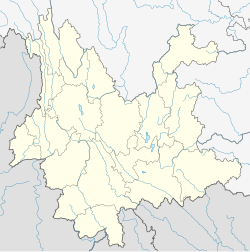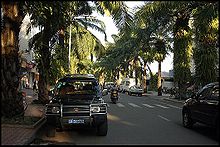world.wikisort.org - China
Jinghong (Chinese: 景洪; pinyin: Jǐnghóng; Tai Lü: ᨩ᩠ᨿᨦᩁᩩ᩵ᨦ; Thai: เชียงรุ่ง, RTGS: Chiang Rung, pronounced [t͡ɕʰīa̯ŋ rûŋ]; Lao: ຊຽງຮຸ່ງ; also formerly romanised as Chiang Hung, Chengrung, Cheng Hung, Jeng Hung, Jinghung, Keng Hung, Kiang Hung and Muangjinghung) is a city in and the seat of Xishuangbanna Dai Autonomous Prefecture, in the far south of China's Yunnan province, and the historic capital of the former Tai kingdom of Sipsongpanna.
Jinghong
景洪市 · เชียงรุ่ง · ຊຽງຮຸ່ງ | |
|---|---|
County-level city | |
 | |
 Location of Jinghong City (pink) within Xishuangbanna Prefecture (yellow) and Yunnan | |
 Jinghong Location of the city centre in Yunnan | |
| Coordinates (Xishuangbanna Prefecture government): 22°00′32″N 100°47′49″E | |
| Country | People's Republic of China |
| Province | Yunnan |
| Autonomous prefecture | Xishuangbanna |
| GB/T 2260 CODE[1] | 532801 |
| Area | |
| • County-level city | 7,133 km2 (2,754 sq mi) |
| Elevation | 558 m (1,831 ft) |
| Population (2010)[2] | |
| • County-level city | 519,935 |
| • Density | 73/km2 (190/sq mi) |
| • Urban | 205,000 |
| Time zone | UTC+8 (China Standard) |
| Postal code | 666100[3] |
| Area code | 0691[3] |
| Climate | Cwa |
| Website | www |
| 1Yunnan Statistics Bureau 2Xishuangbanna Gov. 3Yunnan Portal | |
History
The town was founded as Chiang Hung (Cheli), by Tai king Phanya Coeng in 1180.
Kingdom of Chiang Hung (Sipsongpanna)
During the Mongol Yuan Dynasty in China, the Tai kingdom of Sipsongpanna began a close and long-lasting relationship to Lanna, another historic Tai kingdom that lay south. In 1296, Lanna's capital Chiang Mai was founded by Mangrai, whose maternal grandfather was King Rung Kaen Chai (Thai: รุ่งแก่นชาย) of Jinghong (i.e.: Sipsongpanna).
The kingdoms of Sipsongpanna and Lanna maintained ties through migration and intermarriage.
In 1401, the Sipsongpanna Tai ruler Tau Se Da Xam (pinyin: Dao Xianda) attacked a smaller Tai area to the north unknown as Weiyuan[4] equivalent to modern Jinggu). The Ming administration sought to retaliate but adopted a cautious response of diplomacy and Tau Se Da Xam withdrew his troops. About this period Sipsongpanna began to pay tribute to the Ming.
In 1405 the Sipsongpanna Tai attacked Chiang Mai, in conjunction with Ming Chinese troops.
In 1421 the Chinese attempted to cause a split in Sipsongpanna by backing multiple administrations during a period of civil strife, but their plan failed to succeed.
1448 saw the defeat of Mong Mao, a Tai state in eastern Burma, by a combination of Chinese, Sipsongpanna and allied forces united under the Ming.
In the 1450s another struggle for succession arose in Sipsongpanna, with one faction backed by Kengtung and one by Chiang Mai. Despite the Kengtung faction's victory, conflict started with that state shortly afterwards.
The Burmese Toungoo state arose in the 1530s to crush Chiang Mai, and its influence also extended to Kengtung and Sipsongpanna, which like other Tai kingdoms soon began to pay tribute.
Geography and climate

Jinghong has a latitude range of 21°27'–22°36' N and a longitude range of 100°25'–101°31' E. It borders Pu'er City to the north, Mengla County to the east and Menghai County to the west, as well as Burma's Shan State to the south. The city is limited to the south by Hengduan Mountains, and the Lancang River (Mekong) passes through Jinghong. Two bridges near the city span this river, which flows south-east towards Laos.
Climatically, Jinghong contains elements of both a tropical wet and dry climate and a humid subtropical climate (Köppen Aw and Cwa, respectively). The city has a generally humid climate with strong monsoonal influences. Summer is long and there is virtually no "winter" as such; instead, there is a dry season (December thru April) and wet season (May thru October). Annual sunshine hours amount to between 1800 and 2300 and annual rainfall ranging from 1,100 to 1,700 millimetres (43 to 67 in). The coolest month is December, averaging 18.4 °C (65.1 °F), while the warmest is June, at 27.1 °C (80.8 °F); the annual mean is 23.7 °C (74.7 °F). However, high temperatures reach their peak in April before the onset of the monsoon from the Indian Ocean.
| Climate data for Jinghong (1971−2000) | |||||||||||||
|---|---|---|---|---|---|---|---|---|---|---|---|---|---|
| Month | Jan | Feb | Mar | Apr | May | Jun | Jul | Aug | Sep | Oct | Nov | Dec | Year |
| Record high °C (°F) | 31.5 (88.7) |
34.3 (93.7) |
37.5 (99.5) |
41.1 (106.0) |
40.1 (104.2) |
37.7 (99.9) |
35.7 (96.3) |
35.8 (96.4) |
35.4 (95.7) |
34.1 (93.4) |
31.8 (89.2) |
30.2 (86.4) |
41.1 (106.0) |
| Average high °C (°F) | 25.5 (77.9) |
28.6 (83.5) |
31.9 (89.4) |
33.4 (92.1) |
32.6 (90.7) |
31.5 (88.7) |
30.5 (86.9) |
30.8 (87.4) |
30.6 (87.1) |
29.1 (84.4) |
26.3 (79.3) |
23.9 (75.0) |
29.6 (85.2) |
| Daily mean °C (°F) | 18.5 (65.3) |
20.3 (68.5) |
23.1 (73.6) |
25.7 (78.3) |
26.8 (80.2) |
27.1 (80.8) |
26.5 (79.7) |
26.6 (79.9) |
26.1 (79.0) |
24.4 (75.9) |
21.3 (70.3) |
18.4 (65.1) |
23.7 (74.7) |
| Average low °C (°F) | 11.6 (52.9) |
12.0 (53.6) |
14.4 (57.9) |
18.0 (64.4) |
21.1 (70.0) |
22.7 (72.9) |
22.6 (72.7) |
22.4 (72.3) |
21.6 (70.9) |
19.7 (67.5) |
16.4 (61.5) |
13.0 (55.4) |
18.0 (64.3) |
| Record low °C (°F) | 2.7 (36.9) |
6.6 (43.9) |
6.2 (43.2) |
11.9 (53.4) |
16.2 (61.2) |
18.1 (64.6) |
18.9 (66.0) |
19.3 (66.7) |
16.2 (61.2) |
12.0 (53.6) |
7.2 (45.0) |
1.9 (35.4) |
1.9 (35.4) |
| Average rainfall mm (inches) | 12.4 (0.49) |
14.7 (0.58) |
21.8 (0.86) |
51.5 (2.03) |
126.8 (4.99) |
158.5 (6.24) |
220.2 (8.67) |
197.7 (7.78) |
141.1 (5.56) |
91.2 (3.59) |
59.4 (2.34) |
18.3 (0.72) |
1,113.6 (43.85) |
| Average rainy days (≥ 0.1 mm) | 6.2 | 3.6 | 4.4 | 10.1 | 17.4 | 21.1 | 22.9 | 21.3 | 16.6 | 12.9 | 8.9 | 7.6 | 153.0 |
| Source: Weather China[5] | |||||||||||||
Administrative divisions
Jinghong City has 1 subdistrict, 5 towns, 3 townships and 2 ethnic townships.[6]
- 1 subdistrict
- Yunjinghong Subdistrict (允景洪街道)
- 5 towns
|
|
- 3 townships
- Jingne (景讷乡)
- Dadugang (大渡岗乡)
- Mengwang (勐旺乡)
- 2 ethnic townships
- Jingha Hani (景哈哈尼族)
- Jinuoshan Jinuo (基诺山基诺族乡)
Transport


- Xishuangbanna Gasa International Airport is the second largest airport in Yunnan, located just five kilometers from the downtown. Flights to Kunming, Shanghai, Chengdu and other major cities in China run regularly. There is one weekly international flight to Luang Prabang (resumes 1 November).
- The city has the largest public transportation center in Xishuangbanna and connects travelers to nearby cities, towns and villages.
- China National Highway 214
- China National Highway 213
- Asian Highway Network AH3
- Kunming–Bangkok Expressway
- Xishuangbanna railway station
Places of interest
The Dai Water Splashing Festival and nearby villages of that and other ethnic groups are the main attractions. Additionally, at least three botanical parks and gardens are located in or near the city, of which Xishuangbanna Tropical Botanical Garden is the largest and most famous one.
Notes
- "中华人民共和国国家统计局 >> 行政区划代码". Archived from the original on 2009-02-21. Retrieved 2009-01-29.
- "According to 2010 China National Census". Archived from the original on 2012-03-25. Retrieved 2011-06-08.
- Area Code and Postal Code in Yunnan Province Archived 2007-11-07 at the Wayback Machine
- Wade, Geoff. "Wei-yuan (威遠): Southeast Asia in the Ming Shi-lu: an open access resource". Asia Research Institute and the Singapore E-Press, National University of Singapore. Retrieved 2017-03-25.
- 景洪城市介绍以及其后背景分析——中国天气网 最好最全面天气预报信息资讯平台 (in Chinese (China)). Weather China. Retrieved 2020-04-24.
- "国家统计局" (in Chinese). National Bureau of Statistics of the People's Republic of China. Retrieved 2021-12-07.
References
- Turton, Andrew (ed.) Civility and Savagery: Social Identity in Tai States. Routledge, 2000. (ISBN 0700711732)
- Patterson Giersch, Charles. Asian Borderlands: The Transformation of Qing China's Yunnan Frontier. Harvard University Press, 2006. (ISBN 0674021711)
External links
 Jinghong travel guide from Wikivoyage
Jinghong travel guide from Wikivoyage- Jinghong City Official Website
.
На других языках
- [en] Jinghong
[ru] Цзинхун
Цзинху́н (кит. упр. 景洪, пиньинь Jǐnghóng) — городской уезд Сишуанбаньна-Дайского автономного округа провинции Юньнань (КНР).Другой контент может иметь иную лицензию. Перед использованием материалов сайта WikiSort.org внимательно изучите правила лицензирования конкретных элементов наполнения сайта.
WikiSort.org - проект по пересортировке и дополнению контента Википедии



